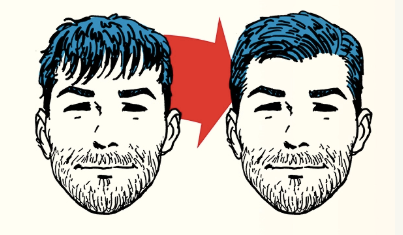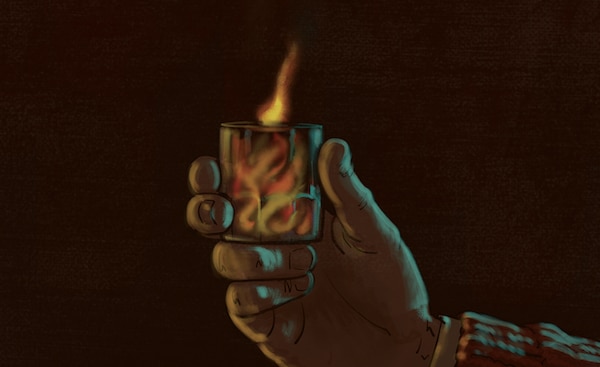
You notice white flakes on your shoulders when wearing a black t-shirt or dark suit.
You’ve got dandruff.
You’re not alone. 50% of adults have dandruff. I’m part of that 50%. I’ve got a more severe type of dandruff called seborrheic dermatitis that I’ve been managing since my early 30s.
While dandruff isn’t a symptom of a serious health issue, those white flakes can get itchy and uncomfortable, aren’t a great look, and can be pretty embarrassing. As we’ll see, dandruff isn’t caused by a lack of proper hygiene, but poor hygiene does make it worse, so that while it may not be fair, people viscerally associate dandruff with “unclean.”
To get the lowdown on managing and treating dandruff, I reached out to celebrity trichologist (a hair and scalp specialist) David Adams, co-founder of FOURTEENJAY salon in NYC. He takes care of the hair of models and actors, folks who are ever in the camera’s eye. Dandruff can hinder these people’s livelihoods, so David’s become an expert on managing this issue.
Do You Have Dandruff or Just a Dry Scalp?
Before you start treating yourself for dandruff, David recommends that you first figure out if you actually have dandruff or simply a dry, flaky scalp.
“A dry, flaky scalp is caused by a lack of moisture on your scalp,” he told me. “When your scalp gets dry, skin gets irritated and flakes off. It’s like having dry skin on any other part of your body.”
The flakes from dry scalp are typically small and, well, dry.
If you have a dry, flaky scalp, using a moisturizing shampoo and a scalp treatment will typically take care of things.
Dandruff is a different beast.
Dandruff flakes are usually bigger and oilier than flakes from dry scalp, and they’re caused by another issue altogether.
What Causes Dandruff?
Your skin produces an oil called sebum at the hair follicle. Sebum is made of both saturated and unsaturated fats. Because your scalp has many hair follicles, your hair produces a lot of sebum. Sebum is what can give your manly mane its shine.
Millions of microbes live on your skin. Among these is a fungus/yeast called Malassezia globosa. Sometimes having M. globosa on your scalp isn’t an issue.
But this fungus can become a dandruff-producing problem if your immune system decides to overreact to Malassezia eating your sebum.
Yes, the yeast on your scalp loves to feast on sebum. And because your scalp has a lot of sebum, it’s like a Golden Corral for M. globosa. But it can only eat the saturated fat part of sebum; it leaves the unsaturated fat part behind. These leftovers pry open the skin barrier on your scalp. Your body detects these skin breaches as a problem and induces an inflammatory response to patch things up.
As part of this inflammatory response, your scalp goes into overdrive in creating new skin cells. These rapidly-made skin cells don’t mature properly, so instead of being integrated into your scalp, they form large, oily clumps around your hair follicles, which are then shed.
A dandruff flake is born.
People’s immune response to M. globosa will vary. Some people have no response (these people don’t get dandruff), while some people have a mild-to-medium response (these people do get dandruff).
People who have a severe inflammatory response get seborrheic dermatitis — a more extreme form of dandruff. If you have seborrheic dermatitis, you’ll have itchy, reddish/yellowish, scaly bumps on your scalp, in addition to dandruff flakes. These bumps and scales can sometimes be painful. What’s more, seborrheic dermatitis can appear on your face — especially along your hairline, near your nose, and on your chin. Some people get it on their chest and back.
Scientists aren’t sure what’s behind these varying immune responses. There are a lot of theories. Some people might have too much Malassezia on their scalp. Other people might have a more permeable skin barrier. Some people might produce too much sebum (men produce more sebum than women, which might be why men are more likely to have dandruff). Other people might just have an overactive immune system. Some scientists speculate that severe forms of dandruff and seborrheic dermatitis may be the result of an autoimmune disease. Stress, food allergies, and certain types of weather might influence the immune response and thus the amount of dandruff a person has too.
Whatever the cause of dandruff, and whether it’s the regular or seborrheic dermatitis kind, it’s not something you can cure. Once you have dandruff, you’ll likely have it for the rest of your life. The best you can do is manage it.
How to Manage Dandruff
David provided the following field-tested tips for managing dandruff. Seborrheic dermatitis is addressed in about the same way, although especially severe cases may need to be treated with steroids.
Because dandruff shampoos can be harsh on your hair, David recommends starting conservatively by taking better care of your scalp. If that doesn’t work, then move to a dandruff shampoo.
Wash your hair regularly. You can still get dandruff even if you practice good hygiene. But poor hygiene can make the problem worse.
In recent times, some hair gurus have started recommending that people not wash their hair regularly since shampooing strips hair of its natural oils. But David argues that “This is just wrong, especially if you have dandruff.”
While David said it’s true that not washing your hair can give it a cool, funky, model-in-a-magazine-type texture and help it maintain its natural shine, “what it’s doing to your scalp is terrible. When you don’t wash your hair and you have dandruff, you’re letting all that sebum, fungus, and skin cells just sit on your scalp. You’re just giving that yeast food to create dandruff.”
So if you have dandruff, wash your hair every day.
Brush your scalp. Before you shower, David recommends brushing your scalp with a special scalp brush, like this one. “It loosens any skin cells or scales on your scalp so that you can wash them off in the shower.”
Massage scalp with cleansing shampoo. Before you start using an anti-dandruff shampoo, David recommends using a gentle cleansing shampoo. He likes using this one from Philip Kingsley with his clients (it is expensive, though). “It’s designed for people with flaky scalps, but isn’t harsh on the hair like anti-dandruff shampoos. You can use it every day.”
When you shampoo your hair, firmly massage the shampoo into your scalp until you’ve covered your entire head three times. The focus should be on your scalp. “A lot of men think shampooing is about cleaning your hair, but it’s actually about cleaning your scalp, so keep your focus on the scalp,” David said.
Thoroughly rinse out the shampoo.
Remember, if you have dandruff, don’t skip on shampooing. You’re just setting yourself up for dandruff flakes.
Apply conditioner, just on the ends of the hair. Shampooing does strip your hair of its natural oils, so David recommends applying a conditioner. We’ve previously gone into detail about hair conditioners for men; check out that article.
David emphasized that you should only apply conditioner to the ends of your hair. You don’t want conditioner on your scalp — that would just provide oily food to the yeast that live on it. After applying conditioner to the ends of your hair, rinse it out thoroughly.
Move to an anti-dandruff shampoo if the above doesn’t work. Give the above routine a shot for a few weeks. David sees an improvement in most clients who regularly use the Philip Kingsley cleansing shampoo.
If you don’t see improvement in your dandruff, consider buying an over-the-counter anti-dandruff shampoo like Head and Shoulders, Selsun Blue, or Nizoral. All of these anti-dandruff shampoos contain antifungal medication that kills the Malassezia that munch on your scalp’s sebum.
The three main antifungal medications in anti-dandruff shampoos are pyrithione zinc (Head and Shoulders), selenium sulfide (Selsun Blue), and ketoconazole (Nizoral).
Anti-dandruff shampoos with salicylic acid or tar coal remove excess skin and slow the growth of skin cells on your scalp.
While all these shampoos can relieve dandruff, they are, as aforementioned, really harsh on your hair. “Using these shampoos regularly will leave your hair looking and feeling brittle and dry,” David told me. In fact, when an actor is trying to remove a temporary hair dye, David recommends using an anti-dandruff shampoo, as it strips everything out of hair — whether color or oil — so effectively.
I’ve tried all of the above shampoos. Head and Shoulders works if you use it every day. You can’t skip. But it does leave my hair dry and wiry. Using a good conditioner and a styling product that provides some moisture can counter the ill effects an anti-dandruff shampoo will have on your hair.
Nizoral is my go-to anti-dandruff shampoo when I have nasty flare-ups of dandruff or seborrheic dermatitis. I just massage it into my scalp and let it sit for a few minutes. During those times when seborrheic dermatitis also migrates onto my face, I’ll massage some of the Nizoral suds into the affected areas and let it sit there, too. I’ll typically see improvement immediately, but especially after the second day of use. The downside of Nizoral is that it really dries your hair out. Make sure to use a good conditioner with it!
Figure out triggers. David also recommends figuring out what’s triggering your dandruff flare-ups. “Certain foods like sugar and dairy can cause dandruff flare-ups in some people,” David told me. Stress (and even excess caffeine consumption, which also elevates cortisol) can trigger dandruff too, so do things to chill the heck out. I’ve also noticed that dry weather can cause my dandruff and seborrhoeic dermatitis to flare up. I get flare-ups when the weather gets cold and dry in Oklahoma, or if I go to the Mountain West during the summer. Just have to stick to my scalp-care routine more closely during those times.
See a dermatologist. If the above tips don’t get your dandruff under control after a few months of use, visit a dermatologist. They may prescribe prescription-strength antifungals or steroids to get things in check.
Dandruff is annoying. Some people have it worse than others. If you’ve got dandruff, you’re not to blame, but there are things you can do to better manage it. Follow the tips above, and you’ll have fewer flakes on your shoulders and feel more confident when you wear your favorite black tee.






